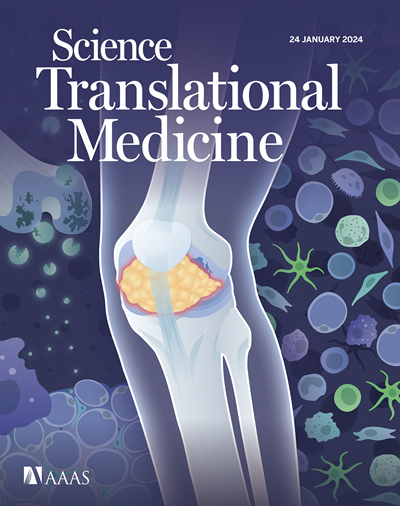Targeted partial reprogramming of age-associated cell states improves markers of health in mouse models of aging
IF 15.8
1区 医学
Q1 CELL BIOLOGY
引用次数: 0
Abstract
Aging is a complex multifactorial process associated with epigenome dysregulation, increased cellular senescence, and decreased rejuvenation capacity. Short-term cyclic expression of octamer-binding transcription factor 4 (Oct4), sex-determining region Y-box 2 (Sox2), Kruppel-like factor 4 (Klf4), and cellular myelocytomatosis oncogene (cMyc) (OSKM) in wild-type mice improves health but fails to distinguish cell states, posing risks to healthy cells. Here, we delivered a single dose of adeno-associated viruses (AAVs) harboring OSK under the control of the cyclin-dependent kinase inhibitor 2a (Cdkn2a) promoter to specifically partially reprogram aged and stressed cells in a mouse model of Hutchinson-Gilford progeria syndrome (HGPS). Mice showed reduced expression of proinflammatory cytokines and extended life spans upon aged cell–specific OSK expression. The bone marrow and spleen, in particular, showed pronounced gene expression changes, and partial reprogramming in aged HGPS mice led to a shift in the cellular composition of the hematopoietic stem cell compartment toward that of young mice. Administration of AAVs carrying Cdkn2a-OSK to naturally aged wild-type mice also delayed aging phenotypes and extended life spans without altering the incidence of tumor development. Furthermore, intradermal injection of AAVs carrying Cdkn2a-OSK led to improved wound healing in aged wild-type mice. Expression of CDKN2A-OSK in aging or stressed human primary fibroblasts led to reduced expression of inflammation-related genes but did not alter the expression of cell cycle–related genes. This targeted partial reprogramming approach may therefore facilitate the development of strategies to improve health and life span and enhance resilience in the elderly.
对衰老相关细胞状态进行有针对性的部分重编程可改善衰老小鼠模型的健康指标
衰老是一个复杂的多因素过程,与表观基因组失调、细胞衰老加剧和再生能力下降有关。在野生型小鼠体内短期循环表达八聚体结合转录因子 4(Oct4)、性别决定区 Y-box 2(Sox2)、Kruppel 样因子 4(Klf4)和细胞髓母细胞瘤病癌基因(cMyc)(OSKM)可改善健康状况,但无法区分细胞状态,从而给健康细胞带来风险。在这里,我们在细胞周期蛋白依赖性激酶抑制剂2a(Cdkn2a)启动子的控制下释放了单剂量的携带OSK的腺相关病毒(AAV),在哈钦森-吉尔福特早衰综合征(HGPS)小鼠模型中特异性地对衰老和受压细胞进行了部分重编程。老化细胞特异性 OSK 表达后,小鼠促炎细胞因子的表达减少,寿命延长。尤其是骨髓和脾脏的基因表达发生了明显变化,老年 HGPS 小鼠的部分重编程导致造血干细胞区的细胞组成向年轻小鼠的细胞组成转变。给自然衰老的野生型小鼠注射携带Cdkn2a-OSK的AAV也能延缓衰老表型,延长寿命,但不会改变肿瘤的发病率。此外,皮内注射携带 Cdkn2a-OSK 的 AAV 还能改善老年野生型小鼠的伤口愈合。在衰老或受压的人类原代成纤维细胞中表达 CDKN2A-OSK 可减少炎症相关基因的表达,但不会改变细胞周期相关基因的表达。因此,这种有针对性的部分重编程方法可能有助于开发改善老年人健康和寿命以及增强复原力的策略。
本文章由计算机程序翻译,如有差异,请以英文原文为准。
求助全文
约1分钟内获得全文
求助全文
来源期刊

Science Translational Medicine
CELL BIOLOGY-MEDICINE, RESEARCH & EXPERIMENTAL
CiteScore
26.70
自引率
1.20%
发文量
309
审稿时长
1.7 months
期刊介绍:
Science Translational Medicine is an online journal that focuses on publishing research at the intersection of science, engineering, and medicine. The goal of the journal is to promote human health by providing a platform for researchers from various disciplines to communicate their latest advancements in biomedical, translational, and clinical research.
The journal aims to address the slow translation of scientific knowledge into effective treatments and health measures. It publishes articles that fill the knowledge gaps between preclinical research and medical applications, with a focus on accelerating the translation of knowledge into new ways of preventing, diagnosing, and treating human diseases.
The scope of Science Translational Medicine includes various areas such as cardiovascular disease, immunology/vaccines, metabolism/diabetes/obesity, neuroscience/neurology/psychiatry, cancer, infectious diseases, policy, behavior, bioengineering, chemical genomics/drug discovery, imaging, applied physical sciences, medical nanotechnology, drug delivery, biomarkers, gene therapy/regenerative medicine, toxicology and pharmacokinetics, data mining, cell culture, animal and human studies, medical informatics, and other interdisciplinary approaches to medicine.
The target audience of the journal includes researchers and management in academia, government, and the biotechnology and pharmaceutical industries. It is also relevant to physician scientists, regulators, policy makers, investors, business developers, and funding agencies.
 求助内容:
求助内容: 应助结果提醒方式:
应助结果提醒方式:


